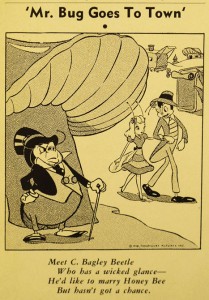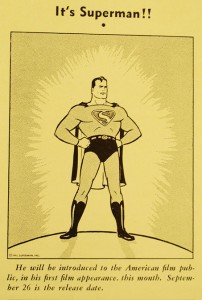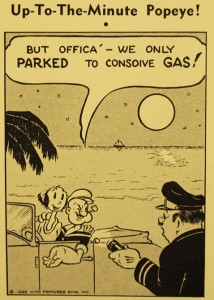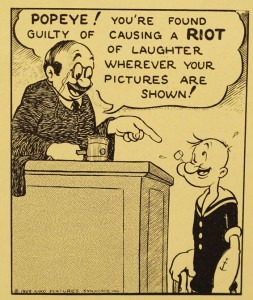September-October 1941
We’re in the homestretch of the Fleischers’ reign now. There’s a fascinating history behind how Paramount got the deal to do the Superman cartoons (a series the Fleischers never wanted to do), but I don’t want to give away any spoilers just yet. They were an expensive series: the wonderful 1941 debut cost $50,000 and each subsequent one was $30,000. Quite a step up from the $16,500 apiece Popeyes.
Mr. Bug Goes To Town would be released the first week of December, 1941. In October 1941, Paramount Sales News began trumpeting the forthcoming full-length Fleischer film in the trades. It was a “feature motion picture cartoon” with a modest budget of $600,000. The cost and production timeline of Dumbo was very similar – and as much as I love the Fleischers’ second foray into feature animation, there’s no debating what the better deal was.











 THAD KOMOROWSKI is a writer, journalist, film restorationist and author of the acclaimed (and recently revised) Sick Little Monkeys: The Unauthorized Ren & Stimpy Story. He blogs at
THAD KOMOROWSKI is a writer, journalist, film restorationist and author of the acclaimed (and recently revised) Sick Little Monkeys: The Unauthorized Ren & Stimpy Story. He blogs at 

























































For Disney, “Dumbo” was a retreat to simpler, seemingly less ambitious storytelling. For the Fleischers, “Mr. Bug” was VERY ambitious, telling a more complex story than “Gulliver” and consciously evoking live actions movies by Capra. That the budget for Disney’s comparative “B” equalled that of the Fleischers’ spectacle says a lot about their respective fortunes.
The September 10 comic is interesting because we’re now showing Popeye and Olive in a car on a beach with a palm street, such as you might happen to see in Miami, Fla. It’s kind of the same effect Leonard Maltin noted 35 years ago, when he said the background of the Popeye shorts got less gritty and brighter the longer the studio was away from New York.
This is a gorgeous print of the original Superman cartoon, but I’ve noticed something — some of the camera movements seem to have been, for lack of a better word, enhanced. I saw occasional, somewhat subtle “zooms” and “swoops” at moments when they were particularly appropriate, something I’ve never seen in any other print. Has someone done some tinkering here? I also found it to be the case with Comic Tube’s print of “The Mechanical Monsters.”
It’s another case of misuse of YouTube’s motion stabilizing option, useful for getting the shakes out of handheld video shots but wrong for finished, edited films like this.
I like the Mad Scientist’s handwriting on his warning letter. Why, a kid could tell you this guy’s dangerous!
People need to stop using that darn thing Peter. You can shut it off on YT but people don’t seem to know how or even care, unless they think they can skirt getting their videos blocked that way.
I have another question about this cartoon. I know that Sammy Timberg and Win Sharples worked together to some extent at Fleischer/Famous before Timberg retired in 1944 or thereabouts; is there any way of knowing the extent of their collaboration? They were both superb arrangers, but the orchestra sounded very different under the direction of each. This cartoon credits Timberg, but to me it sounds like Sharples’s work.
While we’re on this subject, I’ve often said that some of the early B & W Famous Popeye cartoons sound like they were recorded inside a big galvanized barrel. The orchestra sounds much smaller (though I don’t think it was), and the recorded quality of both music and dialogue is just plain “flat” — comparable to that of late ’20s – early ’30s talkies. I’ve never understood why. Once Winston Sharples took over as musical arranger, all of that seems to have instantly changed, for equally mysterious reasons.